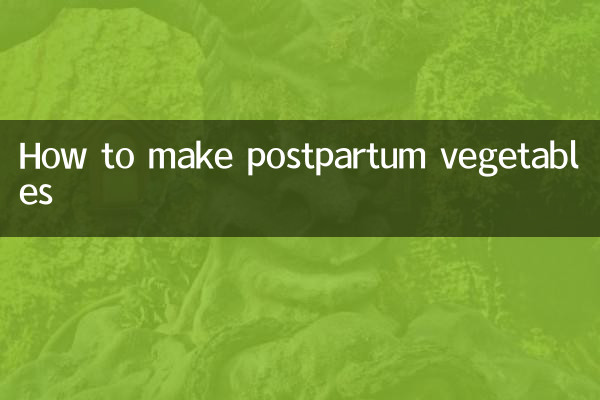How to prepare postpartum vegetables: a complete guide to nutrition and cooking
The confinement period is a critical period for the mother to recover, and dietary conditioning is particularly important. Vegetables are an important source of vitamins, minerals and dietary fiber, and how to scientifically combine and cook them has become the focus of attention. The following is a selection of popular topics on the Internet in the past 10 days about postpartum vegetables, combined with structured data to provide you with a practical guide.
1. Ranking of popular vegetables during confinement period

| vegetable name | Nutritional benefits | Recommendation index |
|---|---|---|
| spinach | Iron and blood supplement, rich in folic acid | ★★★★★ |
| carrot | Rich in vitamin A, promotes wound healing | ★★★★☆ |
| pumpkin | Easy to digest, contains zinc to promote milk secretion | ★★★★★ |
| yam | Strengthen the spleen and stomach, nourish qi and nourish yin | ★★★★☆ |
| broccoli | High in calcium and vitamin C, enhance immunity | ★★★☆☆ |
2. Heat comparison of cooking methods
| cooking method | Applicable vegetables | Advantages | Things to note |
|---|---|---|---|
| steamed | Leafy vegetables, roots and tubers | Retain more than 90% of nutrients | Time is controlled at 5-8 minutes |
| stew | Rhizomes, mushrooms | Easy to digest and absorb | Avoid prolonged high temperatures |
| Quick stir-fry | most vegetables | Maintain crisp and tender taste | Use tea oil or olive oil |
| blanch | Green leafy vegetables | Reduce coldness | Add a little salt when blanching |
3. Top 3 vegetable recipes for confinement are hotly discussed on the Internet
1. Spinach with sesame oil: A popular practice that has recently exceeded 500,000 likes on Douyin. Blanch the spinach, stir-fry it quickly with confinement rice wine and black sesame oil, and finally sprinkle with white sesame seeds. According to actual tests by netizens, it can help improve postpartum constipation.
2. Red dates and yam soup: A popular recipe with a collection of over 100,000 in Xiaohongshu. Steam and mash the yam, add red date juice and a small amount of brown sugar and simmer slowly. Nutritionists recommend eating it as a snack.
3. Serve baby cabbage in soup: An innovative way to eat with a Weibo topic reading volume of 8 million. Use chicken soup as the base, add wolfberry, scallops and baby cabbage to stew. It is suitable for consumption starting from the second week after delivery.
4. Precautions
1.step by step principle: Mainly focus on easy-to-digest melons in the first week, gradually add green leafy vegetables in the second week, and try mushrooms after the third week.
2.Taboo reminder: Leeks, bitter gourd and other milk-returning vegetables should be avoided; pungent vegetables such as onions and garlic should be consumed in small amounts.
3.Seasonal selection: Shepherd’s purse and pea seedlings are recommended in spring; luffa and cucumber are suitable in summer; lotus root and wild rice are preferred in autumn; radish and cabbage are preferred in winter.
5. Special recommendations from nutritionists
| time period | Vegetable pairing suggestions | daily intake |
|---|---|---|
| 1-7 days after delivery | pumpkin + carrot | 200-300g |
| 8-14 days after delivery | Spinach + yam | 300-400g |
| 15-30 days after delivery | Broccoli + Mushrooms | 400-500g |
Through scientific combination and reasonable cooking, postpartum vegetables can not only promote body recovery, but also improve the quality of breast milk. It is recommended to consult a professional nutritionist based on your personal constitution to develop a personalized meal plan. Data shows that mothers who eat vegetables scientifically can improve their postpartum recovery speed by an average of 23%.

check the details

check the details